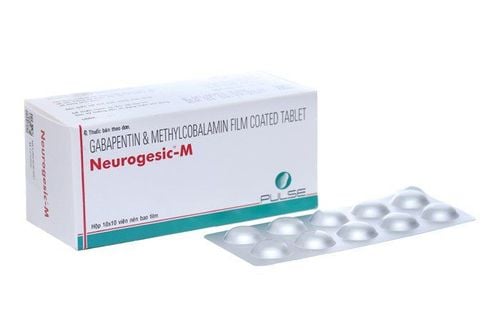This is an automatically translated article.
PMS Pregabalin 75 mg contains the main active ingredient Pregabalin. This medication is used to treat neuropathic pain, epilepsy, and generalized anxiety disorder.
1. What is pms-Pregabalin?
PMS Pregabalin 75 mg contains the main ingredient, pregabalin,. It is used to treat neuropathic pain, epilepsy, and generalized anxiety disorder. PMS Pregabalin 75 mg is made in the form of hard capsules, a box of 4 blisters, each blister contains 15 tablets.
2. What disease does PMS Pregabalin treat?
PMS Pregabalin 75 mg is indicated for use in the treatment of the following cases:
Treatment of central and peripheral neuropathic pain in adults. Treatment of epilepsy: Adjuvant treatment of partial seizures with or without secondary generalization in adults. Treatment of generalized anxiety disorder (GAD) in adults.
3. Usage and dosage of PMS Pregabalin
3.1. How to use PMS Pregabalin: PMS Pregabalin 75mg is made in the form of hard capsules and is for oral use only. The effect of the drug is not affected by food, so you can take it with or without food. 3.2. Dosage of PMS Pregabalin: The average therapeutic dose is 150 to 600 mg per day, divided into two or three times. Neuropathic pain dose: PMS Pregabalin can be started at 150mg per day in two or three divided doses. Based on individual response and tolerability, you may increase the dose up to 300 mg daily after 3-7 days, and if necessary, increase the therapeutic dose up to a maximum dose of 600 mg. every day after 7 days. Treatment of Epilepsy: Pregabalin PMS may be initiated at 150mg per day in two or three divided doses. Based on individual response and tolerability, the dose may be increased to 300 mg daily after 1 week. The maximum therapeutic dose of 600 mg per day can be achieved after another week. Treatment of generalized anxiety disorder: Therapeutic doses of 150 to 600 mg per day are given in two or three divided doses. The need for treatment should be reassessed regularly by qualified physicians. PMS Pregabalin may be initiated at a therapeutic dose of 150mg per day. Based on individual response and tolerability, the dose may be increased to 300 mg daily after 1 week. The doctor may then increase the dose up to 450 mg per day. The maximum therapeutic dose of 600 mg per day can be achieved after another week. Withdrawal of PMS Pregabalin: According to current clinical practice, if discontinuation of Pregabalin is recommended, it should be done gradually, for a minimum of 1 week, independent of the physician's orders.
4. In case of over/forgotten dose
In case of drug overdose: When you overdose on Pregabalin, you may experience unwanted effects including drowsiness, confusion, agitation, and restlessness. Treatment of PMS Pregabalin overdose includes supportive measures and possibly hemodialysis if necessary. In case of an emergency, you need to take the person who overdosed on the drug to the nearest medical facility for timely and correct treatment.
In case of missed dose: If you forget to take a dose, you should try to take it as soon as you remember. However, if it is almost time for your next dose, you should take the initiative to skip the missed dose and take your next dose at the scheduled time. Note that you absolutely do not take the medicine with double the prescribed dose.
5. Undesirable effects of PMS Pregabalin
When using PMS Pregabalin, you may experience unwanted effects (ADRs). The most serious adverse reactions reported were dizziness and somnolence, and were usually of mild to moderate severity. The adverse reactions listed may also be due to the underlying disease and/or concomitant drug use. In the treatment of CNS pain caused by spinal cord injury, the rate of adverse reactions in general, CNS adverse reactions and especially drowsiness has been increased.
Very common side effects are dizziness, drowsiness.
After discontinuing short-term and long-term treatment with PMS Pregabalin, withdrawal symptoms have been reported in some users. Regarding the long-term discontinuation of PMS Pregabalin, there are no data on the incidence and severity of withdrawal symptoms related to the duration and dose of Pregabalin use.
When experiencing side effects of PMS Pregabalin, you need to stop using it and notify your treating doctor or go to the nearest medical facility for timely treatment.
6. Interactions of PMS Pregabalin
Because pregabalin is mainly excreted in the urine unchanged, it undergoes negligible metabolism in humans, does not inhibit drug metabolism, and is not bound to plasma proteins. Therefore, the drug is less likely to cause or be the target of pharmacokinetic interactions. Some drugs that may interact with PMS Pregabalin include:Oral contraceptives, Norethisterone and/or Ethinyl estradiol Ethanol, lorazepam, oxycodone: Pregabalin may increase the effects of Ethanol and Lorazepam. Concomitant use of PMS Pregabalin and other central nervous system depressants may cause respiratory depression or coma. PMS Pregabalin may increase the general decline in cognition and motor function caused by Oxycodone.
7. Some notes when using PMS Pregabalin
Before using PMS Pregabalin, you need to carefully read the instructions for use and refer to the information below.
7.1. Contraindications of the drug PMS Pregabalin is contraindicated in the following cases:
People who are sensitive or sensitive to the active substance or to any of its ingredients. 7.2. Precautions while using the drug People with diabetes : Some people with diabetes gain weight and need to adjust their blood sugar lowering drugs when treated with PMS Pregabalin. Renal Impairment: Cases of renal failure have been reported and in some cases discontinuation of PMS Pregabalin has been shown to reverse this adverse reaction. Lactose intolerant people: In the composition of the drug PMS Pregabalin contains lactose monohydrate. People with rare hereditary problems of galactose intolerance, the Lapp lactase defect or glucose-galactose malabsorption should not take this medicine. People with cardiovascular disease, have factors that can promote brain disease. For children over 12 years of age and adolescents 12 to 17 years of age: safety and efficacy have not been established. Discontinue use of PMS Pregabalin when symptoms of angioedema appear. Controlling signs of suicidal ideation and behavior, PMS drug abuse status Pregabalin. Ability to drive and use machines: PMS Pregabalin may have small or moderate effects on the ability to drive vehicles and use machines. People using this medication are advised not to drive, operate complex machinery, or engage in other hazardous activities until it is known that this medication affects their ability to perform these tasks or activities. them or not. Pregnancy: There are currently insufficient data on the use of PMS Pregabalin in pregnant women. Studies performed in animals have shown reproductive toxicity. PMS Pregabalin should not be used during pregnancy, unless absolutely necessary if the benefit to the mother outweighs the potential risk to the fetus. Lactation: It is not known whether PMS Pregabalin is excreted in human milk, however, it is present in the milk of rats. Therefore, while you are breast-feeding is not recommended during treatment with PMS Pregabalin. Hopefully, the above sharing will help patients understand how to use PMS Pregabalin as well as what to do for the drug to be effective during treatment.
Please dial HOTLINE for more information or register for an appointment HERE. Download MyVinmec app to make appointments faster and to manage your bookings easily.













